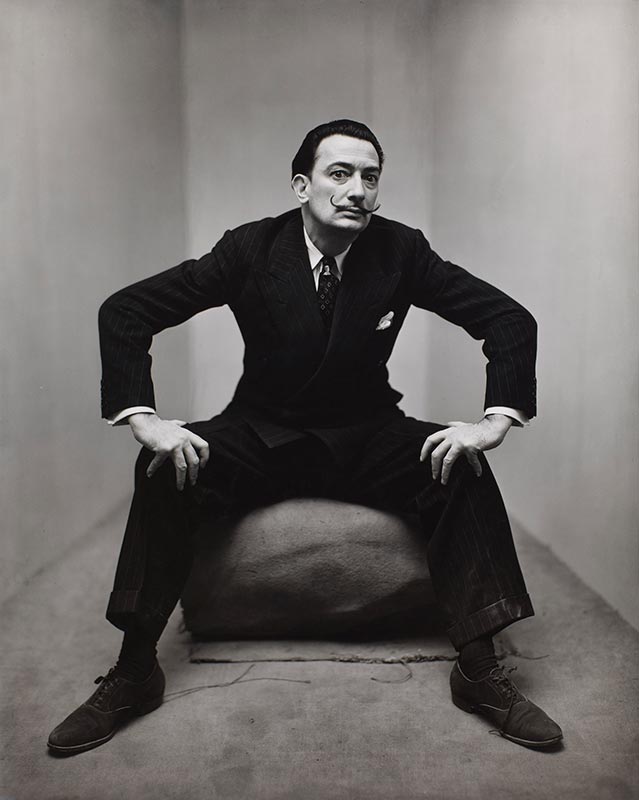He’s known for his fashion and portrait photography, in particular the works that appeared in Vogue, but with a selection of 146 photographs the Smithsonian American Art Museum presents a far more complex picture of famous photographer Irving Penn. This exhibition – the first retrospective since Penn’s death in 2009 – strives to show the full arc of Penn’s career, with its shifting artistic perspectives, rather than focus solely on his fashion aesthetic.
The show opens with early works from the 1930s, a series of note-like photographs of storefronts, hanging signs and shadows in the urban landscape. They reveal Penn’s interest in documenting American reality, beautiful or not – a perspective that is also illustrated in his slightly later photographs of the American South. It is interesting to note the sense of distance between the photographer and the subject in these works. In contrast to his later photographs, in which he confronts his sitters, here he seems to be holding back, an observer rather than a participant. In Snow Balls 2, 3 and 5 cents the attitudes of the men lounging outside the stand dominate the image, while Penn’s shadow creeps from the bottom edge, breaking into the frame somewhat eerily.
Salvador Dali (1947), Irving Penn © The Irving Penn Foundation

While Penn’s still lifes are undeniably intriguing, particularly where they reveal his enduring interest in Surrealism, his portraits are all striking. We can trace the changes in his studio set-up, from his 1940s portraits, which show famous figures such as Salvador Dalí and Truman Capote confined in tight spaces, to his very different pictures (sometimes of the same sitters) from the late ’50s and ’60s, where his subject’s faces fill almost the entire frame.
Penn’s interest in fashion permeates most of his oeuvre. In particular, we see how the worldwide travel he enjoyed through his work at Vogue informed his sense of style and beauty. In one series of portraits, workmen from London and Paris are afforded all the dignity of any Vogue model. Nearby, a set of prints of women from Morocco, New Guinea and Cameroon stand in stark contrast to earlier portraits of poised American women with their tight 1940s silhouettes. A particularly arresting image of four Moroccan women covered in draped cloth (Four Guedras – the Guedra is a type of dance) is followed in the next room by a photograph for Vogue in which Penn’s model wife Lisa Fonssagrives-Penn wears a robe and headscarf in La Bahia Palace, Marrakech.
Sitting Enga Woman (1970), Irving Penn © The Irving Penn Foundation

The composition of each fashion shot seems to be set up to deliver an impression of femininity or style, rather than to offer a clear image of the clothes themselves. Penn’s emphasis on silhouettes, draped fabrics and dark tones results in images that cross the line between fashion and art. His later fashion works such as Ball Dress by Olivier Theyskens for Nina Ricci, and his shots of dresses by Issey Miyake arguably demonstrate a revived focus on the clothes’ design, but they also reveal Penn’s growing interest in movement – another evolution in the artist’s broader aesthetic.
The chronological set up of this show works well, highlighting the quite radical changes in Penn’s approach over the decades. As the 20th-century world evolved, so Penn used his own changing experiences to inspire new techniques. As he moved from his ‘surrealist vision’ of the 1930s, through the freer style of the more stable post-war years, towards an increasingly elegant and ‘modernist’ aesthetic, Penn became bolder in his photographic convictions, confidently following his own interests. But throughout, we see Penn return to themes of beauty and decay, and a certain strangeness that comes from merging reality with keen imagination, both in the real world and in the glamorous world of fashion.
Ball Dress by Olivier Theyskens for Nina Ricci (2007), Irving Penn © Condé Nast

‘Irving Penn: Beyond Beauty’ is at the Smithsonian American Art Museum until 20 March, 2016.



